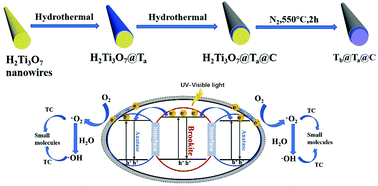Preparation of carbon-coated brookite@anatase TiO2 heterophase junction nanocables with enhanced photocatalytic performance†
Abstract
One-dimensional TiO2@C nanocables with a heterophase junction have been successfully prepared by coating brookite@anatase TiO2 with a thin layer of hydrothermal carbon (HTC). Compared with anatase TiO2, the biphase brookite@anatase structure can reduce the recombination rate of the excited electron/hole pairs of TiO2. The HTC coating not only enhances the adsorption capability of the TiO2 catalyst for organic pollutants but also facilitates photogenerated electron transfer to further increase its photocatalytic activity. Therefore, compared with anatase TiO2, brookite@anatase TiO2, and TiO2@C, the brookite@anatase TiO2@C shows the highest photocatalytic activity for the photodegradation of tetracycline (TC) under the irradiation of UV-visible light. Moreover, ˙O2 has been proved to be the predominant active species for the photodegradation of TC, and the photocatalytic mechanism of brookite@anatase TiO2@C nanocables has also been proposed.



 Please wait while we load your content...
Please wait while we load your content...